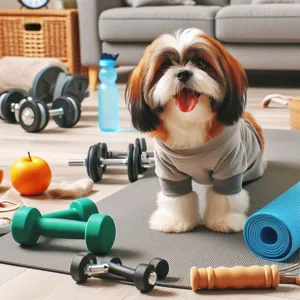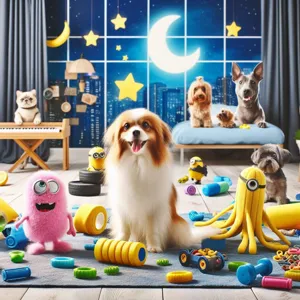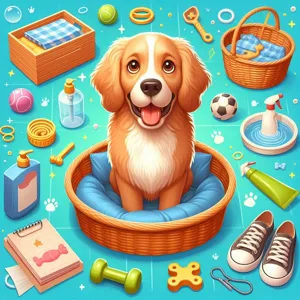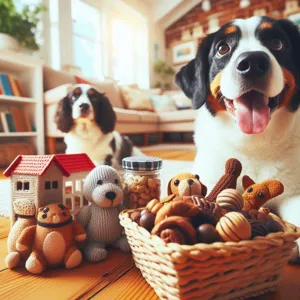Living in a small space can present unique challenges when it comes to keeping your dog active and entertained.
However, limited square footage doesn’t have to mean limited exercise! With a little creativity and resourcefulness, you can turn your cozy apartment or compact home into a vibrant playground for your furry friend. In this blog post, we’ll explore the top 10 innovative ways to exercise your dog in small spaces, ensuring they get the physical stimulation and mental engagement they need to thrive. From interactive games and fun agility exercises to clever use of everyday household items, these ideas will help you bond with your pup while keeping them fit and happy, no matter how tight the living quarters may be. Say goodbye to the guilt of insufficient exercise and hello to a world of playful possibilities!
1. Introduction: The Challenge of Small Spaces for Dog Exercise

Living in a small space can often feel like a challenge when it comes to keeping our furry friends active and engaged. For dog owners, especially those residing in apartments or compact homes, finding ways to provide adequate exercise for their pets requires a bit of creativity and resourcefulness. While sprawling parks and open fields may be out of reach, there are countless opportunities to ensure your dog remains fit, stimulated, and happy, even within the confines of limited square footage.
Dogs, much like their human companions, thrive on physical activity and mental stimulation. Regular exercise is essential not only for maintaining a healthy weight but also for preventing behavioral issues that can arise from boredom and pent-up energy. The good news is that you don’t need vast expanses of land to achieve this; with the right approach, you can transform your cozy living space into a fun and dynamic exercise zone.
Throughout this post, we will explore ten creative ways to exercise your dog in small spaces, ensuring that your pet receives the activity they need to stay cheerful and vibrant. From engaging indoor games to clever uses of everyday items, these ideas will help you turn a limited environment into a thrilling playground for your canine companion. So, let’s dive in and discover how to make the most of your small space while keeping your dog happy and healthy!
2. Indoor Fetch: Creative Variations for Limited Space
Indoor fetch might seem like a simple game, but with a little creativity, it can be transformed into an engaging and stimulating activity, even in the smallest of spaces. Instead of relying solely on the traditional throw-and-retrieve method, consider tailoring the game to fit your surroundings and your dog’s energy levels.
Start by choosing a soft, lightweight ball or a plush toy to ensure you won’t damage any furniture or walls. Clear a small area in your living room or hallway, rearranging furniture to create a safe, open space. To keep the game fresh, introduce variations: for instance, throw the toy down a staircase if you have one, allowing your dog to dash up and down as they chase after it. This adds an extra layer of physical challenge without needing a vast area.
Another inventive twist is to incorporate obstacles. Use cushions, chairs, or boxes as makeshift hurdles that your dog must navigate around to retrieve the toy. This not only encourages physical activity but also engages your dog mentally, as they learn to maneuver through the mini obstacle course. You can even set up a timed challenge, rewarding your pet for completing the course in record time.
For dogs that thrive on mental stimulation, consider hiding the toy in various spots around your small space. This treasure-hunt style of fetch turns the game into an exciting search-and-retrieve mission. Your dog will love the thrill of the chase as they use their nose to sniff out the hidden prize while still getting their exercise.
By mixing up the classic game of fetch with creative variations suited for limited spaces, you can keep your dog entertained and active, ensuring they get the exercise they need while having a blast indoors.
3. Tug-of-War: Engaging Your Dog’s Energy

Tug-of-war is not just a game; it’s a fantastic way to engage your dog’s energy while fostering a strong bond between you and your furry friend. This spirited activity is perfect for small spaces, as it requires minimal room to play while offering maximum mental and physical stimulation.
To get started, grab a sturdy rope toy or a durable tug toy designed for dogs. These toys often have handles that make it easier for you to grip while your dog pulls with all their might. Ensure the toy is safe and the right size for your dog—too small and it could be a choking hazard, too large and it might be difficult for them to manage.
As you initiate the game, encourage your dog to take hold of one end of the toy while you hold the other. Use playful commands like “tug” or “get it!” to ignite their excitement. The beauty of tug-of-war lies in its interactive nature; you’ll quickly notice your dog’s energy levels spike as they engage in a friendly competition with you. This game not only helps to burn off excess energy but also allows your dog to utilize their natural instincts to chase and pull.
Remember to set some ground rules to ensure the game remains fun and safe. Teach your dog commands like “drop it” or “leave it” to prevent any unwanted aggression and to maintain control over the game. Take breaks and switch up the roles now and then, allowing your dog to win occasionally—this builds their confidence and keeps the game enjoyable.
After a few rounds of tug-of-war, your dog will be pleasantly tired and mentally stimulated from the interaction. Plus, this game can easily be modified to accommodate different play styles; whether your dog prefers a gentle tug or a more vigorous pull, there’s always a way to keep the energy flowing in your small space. So, grab that tug toy, get ready for some playful competition, and watch as your dog’s tail wags with joy!
4. Obstacle Courses: DIY Ideas for Small Living Areas
Creating an obstacle course for your dog in a small living area can be a fun and stimulating way to keep them active while also engaging their minds. The beauty of a DIY obstacle course is that it can be tailored to fit the specific dimensions of your space, using everyday household items to craft an exciting adventure for your furry friend.
Start with a clear area, perhaps in your living room or hallway, and gather materials that can serve as obstacles. For example, use couch cushions to create a soft barrier that your dog must jump over, or fashion a tunnel with a few chairs and a blanket draped over them for a cozy crawl space. A broom handle can be propped up on boxes or books to create a jump bar that encourages your dog to leap gracefully over it.
Incorporate weaving elements by placing plastic bottles or cones in a line, encouraging your dog to zigzag through them. You can also include a ‘pause’ station, where they have to sit or lie down before proceeding to the next challenge, reinforcing basic commands and discipline.
To make it even more engaging, time your dog’s performance and reward them with treats for completing the course. This not only adds an element of competition but also strengthens the bond between you and your pet. Rotate the obstacles or switch up the layout every few days to keep things fresh and exciting, ensuring your dog remains mentally and physically stimulated, even in the coziest of spaces. With a little creativity and some simple materials, your dog will have a fantastic time navigating their very own indoor obstacle course!
5. Hide and Seek: A Fun Game for Mental Stimulation

Hide and Seek is not just a game for kids; it’s also a fantastic way to engage your dog’s mind and body, especially in the confines of smaller spaces. This activity taps into your dog’s natural instincts, providing both mental stimulation and a healthy dose of exercise. To set up this game, start by having your furry friend sit and stay in one room while you choose a hiding spot in another. It could be behind a door, under a table, or even in a closet—just make sure it’s safe and accessible.
Once you’re hidden, call your dog’s name and encourage them to find you. Use cheerful, enthusiastic tones to make the game even more exciting! As your dog scours the space, sniffing and searching for you, they will not only be physically active but also mentally engaged, honing their problem-solving skills.
For added fun, you can incorporate treats or their favorite toy as incentives. When your dog finds you, shower them with praise and rewards, reinforcing the behavior and creating a positive association with the game. As they become more adept at finding you, you can increase the difficulty by hiding in more challenging spots or even hiding their toys around the space.
This interactive game not only helps to burn off energy but also strengthens the bond between you and your pet. The thrill of the chase, combined with the joy of discovery, makes Hide and Seek a delightful way to keep your dog entertained and exercised, even when space is limited. So grab your pup, find a cozy spot, and let the fun begin!
6. Interactive Toys: Keeping Your Dog Active Indoors
When it comes to keeping your furry friend entertained and exercised indoors, interactive toys can be a game-changer. These engaging gadgets are designed to stimulate your dog’s mind and body, transforming a small living space into an exciting playground. From treat-dispensing puzzles to electronic fetch toys, the options are endless, each catering to different play styles and energy levels.
Imagine your dog’s excitement as they paw at a brightly colored puzzle that dispenses treats when they solve it. Not only does this keep them physically active as they maneuver the toy around, but it also provides mental stimulation, keeping their curious minds engaged. Interactive toys can help alleviate boredom and reduce destructive behaviors that often arise when dogs don’t have an outlet for their energy.
For those rainy days when outdoor play is off the table, consider investing in a few high-quality interactive toys that require your dog to think critically and problem-solve. Brands that specialize in dog enrichment often offer a variety of difficulty levels, allowing you to tailor the challenges to your pup’s abilities.
Additionally, rotating toys regularly can keep the novelty alive, preventing your dog from losing interest. You could even create mini obstacle courses with a mix of toys, encouraging your dog to explore, jump, and navigate their way through a dynamic indoor environment. With the right interactive toys, you can ensure your canine companion stays active, engaged, and happy, even in the smallest of spaces.
7. Trick Training: Combining Learning with Exercise

Trick training is a fantastic way to combine mental stimulation with physical exercise, making it an ideal option for keeping your dog engaged, especially in small spaces. This method not only taps into your dog’s natural curiosity and desire to learn but also provides a productive outlet for their energy.
Start with simple tricks like “sit,” “shake,” or “roll over,” and gradually progress to more complex feats like “spin,” “play dead,” or even fetching specific items by name. The beauty of trick training is that it can be done in a small living room or even a cozy hallway, requiring minimal space while maximizing engagement.
Using positive reinforcement techniques—like treats, praise, or playtime—helps create a positive learning environment for your furry friend. Each successful trick can be celebrated with enthusiasm, reinforcing the bond between you and your dog while keeping them motivated to learn more.
Incorporating tricks into their daily routine not only helps to burn off excess energy but also provides a fantastic mental workout, reducing boredom and destructive behaviors. Plus, the joy and satisfaction of mastering a new trick can be immensely fulfilling for both you and your dog, making this training session a fun exercise to look forward to. So grab some tasty treats, clear a little space, and watch as your dog shines in their newfound skills!
8. Using Stairs: A Simple Way to Increase Activity
Using stairs can be an incredibly effective way to increase your dog’s activity level, especially in small spaces where room to roam is limited. If you live in a multi-story home or have access to a set of stairs, you hold a hidden gem for canine exercise right at your fingertips.
Stair climbing is a dynamic workout that engages your dog’s muscles, providing both aerobic and strength-building benefits. The incline helps to elevate their heart rate, making it a fantastic way to burn off excess energy. To get started, simply encourage your dog to follow you up and down the stairs. Use treats or their favorite toy as motivation; this not only makes the exercise enjoyable but also reinforces positive behavior.
For added engagement, you can incorporate games. For instance, toss a toy or a ball up the stairs and have your dog retrieve it. This creates a fun challenge and keeps their mind sharp while they scamper back and forth. Just be cautious; ensure the stairway is free of obstacles to avoid any slips or tumbles, especially for younger or older dogs.
Alternatively, if you want to ramp up the intensity, try setting a timer for intervals. For example, have your pup sprint up the stairs for 30 seconds, followed by a brief rest period at the bottom. Repeat this a few times, keeping an eye on your dog’s energy level to prevent overexertion.
Overall, utilizing stairs not only maximizes your small space but also provides a unique way to bond with your furry friend while promoting their physical health. So, the next time you’re looking for a creative way to exercise your dog indoors, remember that those stairs can be a great ally in your quest for a happy, healthy pup.
9. Dance Party: Get Moving with Your Dog
When it comes to getting your heart rate up and having a blast with your furry friend, a dance party is a perfect solution for exercising your dog in a small space. Gather your pup in the living room, crank up your favorite playlist, and let the rhythm take over!
Start by establishing a fun atmosphere—dim the lights, add some colorful decorations, or even toss in a few dog-friendly treats as incentives. As the music begins to play, encourage your dog to join in the fun. You can use treats or toys to entice them to jump, spin, and wiggle alongside you. Not only does this playful engagement strengthen your bond, but it also provides a fantastic mental and physical workout for both of you.
Incorporate different moves to keep the session lively: have your dog weave between your legs, spin in circles, or hop up for a high-five. Remember to mix up the tempo and style of music to maintain excitement—fast beats can encourage enthusiastic jumping, while slower tunes can allow for some gentle stretching and movement.
Capture the moment by taking videos or photos; your dog will look adorable and it may inspire others to join in the fun! Plus, sharing your dance party on social media can create a sense of community among fellow dog lovers, who may share their own creative exercise techniques.
So, whether you’re shaking it to the latest hits or busting out some old-school classics, a dance party is a joyful way to keep your dog active and entertained, even in the coziest of spaces!
10. Short Indoor Walks: Making the Most of Hallways
When space is limited, every inch counts, and hallways often become the unsung heroes of indoor exercise routines. Short indoor walks can transform what might seem like a mundane corridor into an engaging workout zone for your dog. The key is to maximize the length and potential of your hallway while keeping your furry friend entertained.
Start by adding some variety to the stroll. Use a mix of pacing—alternating between brisk walks and slow, leisurely strolls to create a dynamic experience. Consider incorporating fun commands along the way; ask your dog to sit, stay, or perform tricks at designated spots. This not only exercises their body but also stimulates their mind, providing a well-rounded workout.
To further enhance the indoor experience, you can introduce interactive elements along the route. Scatter a few toys or treats at intervals, encouraging your dog to sniff them out or retrieve them. This scavenger hunt approach keeps them engaged and excited about the journey down the hallway. You might even set up a small obstacle course using cushions or furniture to encourage jumping and weaving, ensuring your pup gets a good mix of cardio and agility training.
Finally, don’t underestimate the power of play during these walks. Bring along a favorite toy for a quick game of tug-of-war or fetch, using the space efficiently without overwhelming your surroundings. By turning your hallway into a fitness playground, you can ensure your dog gets the exercise they need, all while deepening the bond you share. Short indoor walks may seem simple, but they can be a fantastic way to keep your dog active and happy, even in the smallest of spaces.
11. Set Up Playdates: Socialization in Small Spaces
Setting up playdates for your dog can be a fantastic way to provide both exercise and socialization, even in small spaces. Dogs are social creatures, and interacting with other dogs can help them burn off energy while also improving their behavior and happiness. If you live in a compact apartment or a cozy home, consider inviting a friend or neighbor with a dog to join you for a playdate in your living room, backyard, or even a nearby park.
To make the most of these playdates, create a safe and engaging environment. Clear any fragile items from the area and set up a designated play zone with toys that encourage active play, like squeaky balls or tug ropes. If space allows, sprinkle in some agility equipment like tunnels or small hurdles to add an extra layer of fun and challenge.
Monitoring the dogs during their playtime is essential. Keep an eye on their interactions to ensure they’re playing nicely and taking turns. This not only helps prevent any potential scuffles but also allows you to step in and redirect their energy if things get too rowdy.
Moreover, playdates are not just beneficial for your dog—they can also foster a sense of community among pet owners. Sharing tips, advice, and experiences can lead to lasting friendships while ensuring your furry friend gets the social interaction they crave. So gather some fellow dog lovers, set a date, and watch your pup thrive in the company of new canine companions, all without needing a sprawling backyard.
12. Utilizing Outdoor Areas: Parks and Patios
When living in a smaller space, it can sometimes feel like your options for exercising your dog are limited, but fear not! Utilizing outdoor areas like parks and patios can open up a world of possibilities for keeping your furry friend active and engaged.
**Parks:** Local parks are a dog owner’s best friend. They provide a wide-open space for your dog to stretch their legs, engage in some spirited play, and socialize with other pups. Even if you live in a bustling urban area, chances are there’s a park nearby that welcomes dogs. These green oases offer a perfect opportunity for games of fetch, frisbee, or simply letting your dog run free. Just be sure to keep an eye out for dog-friendly hours and leash requirements, and always have some water on hand to keep your pet hydrated.
**Patios:** If you’re fortunate enough to have access to a patio or balcony, you can turn this small outdoor space into a mini exercise zone. Set up a safe area where your dog can play with their favorite toys, or create a small agility course using household items like cones or hula hoops. You can also incorporate interactive toys that challenge your dog mentally and physically, such as treat-dispensing puzzles.
Moreover, consider doing short training sessions outside on the patio. Teaching your dog new tricks or reinforcing commands in a fresh environment can turn exercise into a fun and rewarding experience.
Whether you’re hitting the local park or transforming your patio into a play zone, getting outside is essential for your dog’s well-being. These outdoor spaces not only provide ample room for physical activity but also allow for a change of scenery that keeps your dog’s routine exciting. With a little creativity, you can ensure that your dog gets the exercise they need, no matter the size of your living space.
13. Incorporating Agility Exercises: Small-Scale Equipment Ideas
When living in a small space, it might seem challenging to provide your dog with the physical and mental stimulation they crave. However, incorporating agility exercises into your routine can transform even the tiniest areas into a fun and engaging playground for your furry friend. All you need is a bit of creativity and some small-scale equipment to get started!
First, consider investing in a set of agility cones or markers. These can easily be arranged to create a mini obstacle course, encouraging your dog to weave in and out while enhancing their coordination. Pair this with a tunnel, which can be purchased or even made from a collapsible laundry basket, allowing your dog to practice their speed and agility as they dash through.
Jumping exercises are another exciting option. Use soft, low obstacles like broomsticks balanced on sturdy boxes or cushions. This not only challenges your dog’s jumping ability but also keeps them engaged as they learn to navigate these barriers. Just ensure any jumps are low enough to prevent injury.
Additionally, you can create a balance beam using a sturdy piece of wood laid flat on the ground. Teaching your dog to walk across it can improve their balance and core strength. For an added challenge, introduce turns or pauses as they navigate the beam.
Lastly, don’t underestimate the power of interactive toys that promote agility and mental stimulation. Puzzle feeders and treat-dispensing toys can turn mealtime into a fun agility challenge, encouraging your dog to figure out how to access their favorite snacks while using their body in a controlled way.
By creatively incorporating these small-scale agility exercises into your dog’s routine, you can provide them with an enriching experience that promotes physical fitness and mental sharpness—all within the confines of your cozy living space. Your dog will not only enjoy the challenge but will also build confidence and strengthen the bond you share through play.
14. Conclusion: Finding Joy in Exercising Your Dog Indoors
In conclusion, exercising your dog indoors can be a joyful and fulfilling experience for both you and your furry friend. While small spaces may seem limiting at first, they can actually inspire creativity and innovation in how you engage your pet. From interactive games that stimulate their minds to fun agility courses crafted from everyday items, the possibilities are as vast as your imagination.
Embrace the moments of play and exploration; each playful session strengthens your bond and keeps your dog physically and mentally stimulated. Remember, the key is consistency and variety—keep it fresh to maintain your dog’s enthusiasm.
Furthermore, incorporating regular indoor exercise into your routine not only helps maintain your dog’s health but also provides a sense of adventure and accomplishment for you both. Whether it’s a spirited game of tug-of-war or a rigorous training session, every activity contributes to a happier, healthier dog. So, roll out the mats, gather your toys, and let the fun begin! With a little effort and creativity, exercising your dog indoors can become a rewarding part of your daily life, fostering joy and connection that lasts a lifetime.
15. Bonus Tips: Maintaining Your Dog’s Health in Small Spaces
While exercising your dog in small spaces presents unique challenges, it’s also an opportunity to get creative about your pet’s overall health and well-being. Here are some bonus tips to ensure your furry friend remains happy and healthy, even within the confines of a cozy apartment or a small yard.
**1. Mental Stimulation is Key:** Just as physical exercise is crucial for your dog, mental stimulation plays an equally important role in keeping them engaged and happy. Invest in puzzle toys that require problem-solving, or teach your dog new tricks using positive reinforcement techniques. A mentally tired dog is often a calmer dog, which can be especially beneficial in smaller living environments.
**2. Schedule Regular Vet Visits:** Don’t forget about routine veterinary check-ups! Regular health screenings can help catch potential health issues early. Discuss your dog’s exercise needs with your vet, and ask for tailored recommendations that suit your space constraints.
**3. Balanced Diet:** A well-balanced diet is essential for maintaining your dog’s health. Consult with your veterinarian to determine the best food tailored to your dog’s age, size, and activity level. Remember, a well-fed dog is often a more energetic and playful companion, regardless of the size of your space.
**4. Create a Routine:** Dogs thrive on consistency. Establish a daily routine that includes playtime, training, and relaxation. Regular schedules can help reduce anxiety and promote a sense of security, making your pet feel more at home in their environment.
**5. Utilize Vertical Space:** If you’re limited in floor space, think vertically! Set up shelves or climbing structures where your dog can safely explore. This not only utilizes space effectively but also encourages physical activity in a fun and engaging way.
**6. Engage with Interactive Games:** Invest in interactive dog games that can be played indoors. From tug-of-war to hide-and-seek with their favorite toys, these activities can keep your dog entertained while providing the exercise they need.
**7. Indoor Agility Course:** Create a mini agility course using furniture and household items. Use cushions, chairs, and boxes as obstacles for your dog to navigate. This can be a fun way to challenge their agility and coordination while maximizing your space.
By incorporating these tips into your routine, you can ensure that your dog remains healthy, happy, and mentally stimulated, even in the smallest of living spaces. Remember, a little creativity goes a long way in maintaining your furry friend’s well-being!
In conclusion, keeping your dog active and engaged in small spaces doesn’t have to be a challenge. With the creative strategies outlined in our blog post, you can transform even the coziest living areas into an exciting playground for your furry friend. From interactive games that stimulate their minds to fun indoor workouts that help burn off excess energy, these activities will not only enhance your dog’s physical health but also strengthen the bond you share. So, grab some toys, clear a little space, and get ready to embark on a joyful journey of play and exercise right at home. Your pup will thank you with wagging tails and happy barks!






